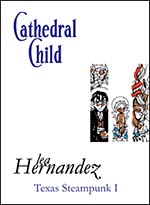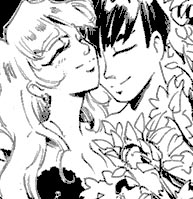>> The Friday Review: The Tale Of One Bad Rat
>> The Friday Review: Cathedral Child
More...

 Writer/Artist: Lea Hernandez
Writer/Artist: Lea Hernandez
Price: US $10.95
Publisher: Cyberosia (July 2002)
ISBN: 0-9709474-5-3
Steampunk is one of those genres that comes with a set of expectations. Such stories are usually set in smoky Victorian London, where the terribly cunning schemes of dashing gentlemen are played out against the backdrop of an industrial revolution accelerated by gargantuan calculating machines.
So it's refereshing to find very few of these elements feature in Lea Hernandez' TEXAS STEAMPUNK trilogy, of which CATHEDRAL CHILD is the first instalment. This is steampunk in the Old West, where the only high-speed communications network involves horses.
The plot of CATHEDRAL CHILD stems from the corrupted brilliance of Parrish Stuart and his construction of the giant analytical engine Cathedral, which takes its name from the church that houses it. Stuart believes that Cathedral can be taught to think via the church organ that serves as the user-interface. This task is given to tutors, mainly taken from the local native 'Cuerpo De Cathedral', who show a particular aptitude for communicating with the musical computer.
Stuart's adopted sun Sumner also works with Cathedral from a young age, thereby meeting the Cuerpo known as Glory and embarking on the relationship that gives the story its central thread. As Glory and Cathedral grow in parallel, becoming able to communicate without the organ keyboard, it becomes apparent that Cathedral plays host to another virtual entity, Camille. This ghost in the machine yearns to be free and, as Old Magic interfaces with New Technology, her wish is granted in a way that no one could have quite anticipated.
'Hernandez's manga-styled artwork is a delight.' Hernandez sets herself some ambitious goals for this story, following the lifelong relationship between Glory and Sumner as it blossoms into romance. The culture of the Cuerpos is established, and sufficiently well realised as to allow examination of how our young lovers contend with society's disapproval of their crossing the social divide.
All this is set against the backdrop of Cathedral's "growth" into a thinking entity, and the sinister machinations of Parrish and his financiers. So it's impressive that nothing seems glossed over (except perhaps the slightly distracting introduction of the clearly-not-to-be-trusted Sacerdote, who does have a much larger role in the next book) as the plot zips along at lightning pace.
Hernandez's manga-styled artwork is a delight. It skilfully depicts scenes as contrasting as the touching innocence of Glory and Sumner as children, the joyous abandon as Cathedral and Glory first communicate, and the dynamic action as the story climaxes. There is a lack of background detail, but in such a strongly character-driven work it really isn't a problem.
Another feature of the artwork is the way that the number, layout, size and shape of the panels is constantly varied, depending on the requirements for a given scene. The passage of time from one season to another is shown in a series of regular ordered rectangles, whereas the more kinetic sequences take place in jagged angular panels.
Panel borders vanish entirely as we're immersed in Cathedral Dreams. Word balloons adorned with musical notes hang in the air like haunting melodies as Cathedral revels in finding its voice. Hernandez plays with the format still further by abandoning sequential panels altogether now and again, such as the bookends to the story. Here we open with a scene-setting letter from Parrish, and close on a double-page scrapbook-style presentation of a series of newspaper articles hinting at "what happened next" for various characters.
 Of course, this constant experimentation does demand a little extra effort from the reader, and though the correct panel-to-panel transition isn't always immediately obvious, it's never confusing for long. Similarly, the occasional idiosyncratic placement of unattributed speech bubbles can cause temporary confusion as to which character is speaking.
Of course, this constant experimentation does demand a little extra effort from the reader, and though the correct panel-to-panel transition isn't always immediately obvious, it's never confusing for long. Similarly, the occasional idiosyncratic placement of unattributed speech bubbles can cause temporary confusion as to which character is speaking.
CATHEDRAL CHILD has been a bit of an orphan for its short and slightly troubled life. Originally intended for the now-defunct Eclipse line, it first saw print for Image in 1998. Having been allowed to go out of print there, it's now been repackaged by up-and-coming independent publishers Cyberosia. What's more, this new edition has re-mastered artwork to fix the printing problems with the Image version, and an added DVD-like commentary section by Hernandez herself. Cyberosia is also rereleasing the second part of the TEXAS STEAMPUNK trilogy, CLOCKWORK ANGELS, and the third, IRONCLAD PETAL, should be available in 2003 after making it's debut online at Modern Tales.
Hopefully TEXAS STEAMPUNK will reach more people this time round, as Hernandez has proven herself a talent on the rise since the book first came out. As well as working with Peter David on Marvel's Mangaverse version of PUNISHER, Hernandez has also contributed to Warren Ellis' TRANSMETROPOLITAN at DC Vertigo, and worked with Gail Simone (AGENT X) on the feisty and funny KILLER PRINCESSES series for Oni Press.
But it 's CATHEDRAL CHILD where things began and, despite the magic and music and computers, this is ultimately a love story. It's the story of young love between Sumner and Glory, fighting to overcome social obstacles, and the story of the love of life that drives Cathedral and Camille to risk everything to experience it more fully. As a debut release it isn't quite as polished as some of Hernandez's later works, but there's so much energy in the art and so much intelligence in the script that it's easy to forgive a few rough edges.

This article is Ideological Freeware. The author grants permission for its reproduction and redistribution by private individuals on condition that the author and source of the article are clearly shown, no charge is made, and the whole article is reproduced intact, including this notice.


